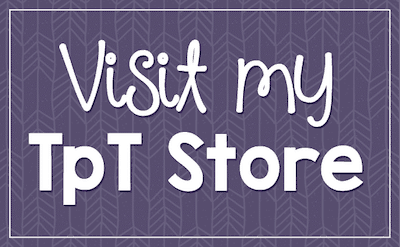
As a mom, I speak French at home. During the day, my son goes to a French immersion school, and he spends all day speaking French. He doesn’t understand how to conjugate verbs yet, but he does know how to use them correctly in many tenses. He’s not even 100% sure what a verb is yet, but somehow he knows that je joue ends with e and not es or ent. How? He sees it everywhere in the classroom. He reads it, and he already knows what it sounds like, so ending some other way would just be weird to him.
It would also be really weird to him if his teacher began French class with a verb chart and made him sit and memorize endings. Or even stranger still… if he opened up a book and started repeating vocabulary words after his teacher. Yes, maybe sometimes these things will happen, but it should not happen for every verb or vocabulary word for every unit!
So, what can you do if you’re not a French immersion teacher to help students gain fluency as quickly as possible in a more natural way? Here are some things I’ve learned from teaching FSL and French immersion. Neither model is perfect, but in my experience, immersion is by-far a quicker path to fluency.
1. Don’t translate everything.
I know that this is easier. I know students love to get a nice, comfortable vocabulary list with the words side by side. This is easy, but it isn’t really practical. Maybe you can give them this list AFTER you have presented the vocabulary in context.
How to do this?
TPR! I love to talk and tell stories. I’m silly, and I tell a lot of stories about my husband. (He HATES this, mainly because my classes go crazy with the TPR stories, and they never end! He doesn’t find the stories we tell as amusing as we do).
Vocabulary in context is not so easy for beginners, though, so how do you present it effectively? Bring in the actual items when you can. Print word walls with the image and the French word. Find a short video with some of the words, or give them a short reading comprehension activity and have them guess the meaning of the words.You can also tell a short story, draw, or act out some of the words.
2. Correct students when they are wrong.
This goes for FSL and French immersion teachers. While we think we are discouraging students when we correct them, what we are actually doing is helping prevent students from fossilizing these mistakes. I can’t tell you how many very-near fluent immersion students I’ve taught who say things like, “Quand j’étais cinq” or “J’ai tombé.”
It is totally natural to make mistakes like this, but if we let it go on, it gets worse and worse. If your child said, “I goed,” you would correct them, so please don’t let your students say “J’ai allé!” Even when students know it is wrong, they have a much harder time avoiding these errors after time.
3. Music!
Use music as much as you can. Whether I’m teaching FSL or French immersion, we listen to music every week. Some students really learn best this way, and it is just more fun anyways. Here are some of my favorite French Songs for Secondary Students.
4. Give them lots of visuals.
If you want your students to ask for help in French, ask permission to get up, go to the restroom, or anything else, you have to encourage that by giving them handy visuals. Even students who speak a lot of French still benefit from anchor charts and notes. Once they are in place, you can simply motion towards the poster and the students will remember your expectation to use their French.
These printable signs are perfect for beginners or in a French immersion classroom. Find them HERE.

5. Maximize your time with students.
French immersion students get to hear and communicate in French for hours a day whereas your students only get a few hours a week with you. This means that they need to hear as much from you as they can. So, speak French as much as you can!
Related : Get your students speaking French!
This also means that what is in your textbook might not always be what is the most important. (Yes, really!) So what’s important? Well, all of it is, but just below, I’ve listed the two areas I like to focus on the most with beginners.
French verbs
The first exposure to a verb should always be with je and tu. They can get used to the idiomatic expressions and get speaking with only these two subjects. A great way to do this is with a Find Someone Who activity. After students are comfortable this, you can move on to speaking cards that you use daily, and when students are ready, you can add in the other subjects.

French vocabulary
Don’t limit your students to vocabulary lists from a textbook. We usually add 5-10 new words each class period based on what comes up in the context of the class. I write them on the board as they come up, then I make a point of coming back to those words over and over throughout the week. I put up word wall cards so they have exposure to more words, even if I don’t teach them expressly.
If you have some extra time, add some fun with a Bingo game. Your students might not remember every single term, and that’s okay. The goal is exposure. You want to expose them to as much as you can, and while you will have the non-negotiable items that they must know for your course, every other term they learn just gets them one step closer to fluency.
Beyond that, I’m not going to tell you that grammar doesn’t matter, because it does. There are even people out there that like grammar. (Guilty!) However, does it matter if your students don’t know what direct objects and prepositions are? Not really. I bet they don’t all know what they are in English, but they won’t have trouble telling you that they are in school, on time, or that they gave it to you. What matters is that they can USE them.
What do you do to bring more French immersion into your classroom? I’d love to hear your thoughts in the comments below!



Shanelle MacKenney says
Salut Ashley, I am currently a student teacher studying in BC, Canada to become a Core French Elementary teacher and find all of your tips to be extremely helpful! I really like how you emphasize the importance of giving students contextually relevant experiences, because simply memorizing vocabulary won’t help them when they find themselves in authentic French settings. I think it’s great that you use a variety of platforms to communicate with your students, as it helps them make memorable connections to the content and promotes more engaging learning opportunities. Movement, music, and art are great to incorporate because they also provide students with insights on aspects of French culture. You make a great point by making every minute count and aiming to expose the students to as much French as possible. With consistent exposure, students move closer to fluency and don’t have to relearn content at the beginning of each year.I will keep all of these helpful tips in mind as I begin my teaching career. Thanks for all of the resources too! Shanelle
Ashley says
Salut Shanelle.
Thank you for your kind words! It seems like yesterday I was just studying to be a teacher, and suddenly it's year 13! Time goes by so fast, and before you know it, you'll be in your own classroom. I'm really glad the tips are helpful to you. I learned a LOT by trial and error…so I had my share of flops! It happens, and it's how you get better. Teaching is really one of the most inspiring jobs you'll find, and I hope you absolutely love it!
Best of luck to you. 🙂
💜Ashley